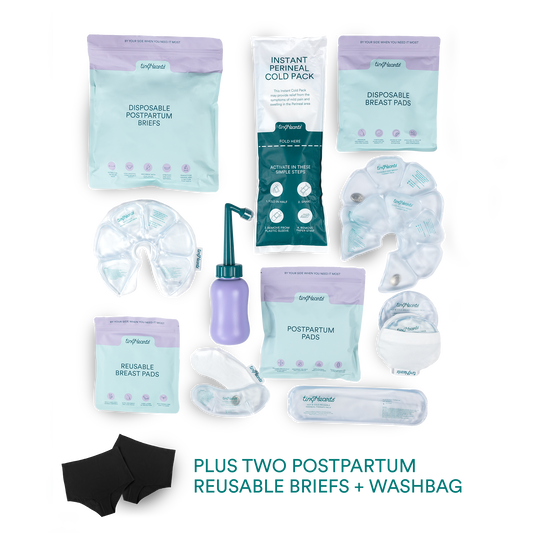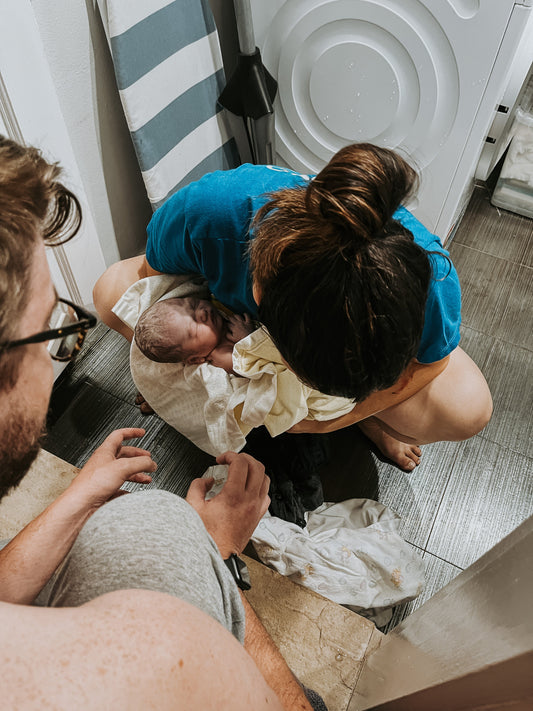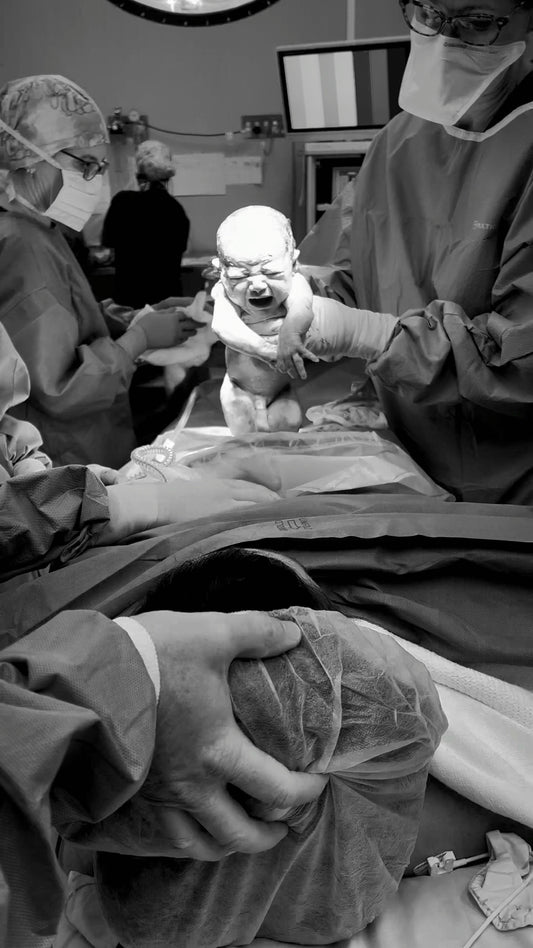Part of being prepared for a vaginal birth means knowing your pain relief options for labour.
All pain relief options can be categorised into one of the following:
- Non-pharmacological [non-medication]
- Pharmacological [medication]
Non-pharmacological pain relief
Non-pharmacological pain relief works on the gate-control theory. This theory suggests that the brain can only take in and notice so much stimuli at one time. It's kind of like herding sheep. Only so many sheep can go through a gate at once. Some will get through the gate, but some won't. The sheep that can't fit through wait outside the gate and aren't noticed so much by the farmer inside the gate. Now think of the farmer as the brain and the competing sheep as non-pharmacological pain relief and contractions. Without non-pharmacological pain relief sheep, all the contraction sheep will get through the gate and flood the brain with pain signals. But if non-pharmacological pain relief sheep are present, they'll compete against the contraction sheep to get through to the brain. That means that less contraction sheep are getting through, meaning the farmer [your brain] notices less pain.
Massage
Massage is when a support person or Midwife rubs a mama's back, neck, shoulders, lower back or hips as a way of reducing pain from contractions. Massage can be soothing for a mama, particularly when completed using birth oils and in combination with other forms of non-pharmacological pain relief.
Positives of using Massage:
- It can allow a mama to labour freely.
- It doesn't require extra monitoring, has no side effects and doesn't affect bub in any way.
- It can help a mama avoid pharmacological pain relief if that's what she chooses.
- It helps a mama relax.
- While there is no proven theory, researchers think massage either floods the brain with pleasant sensations, therefore blocking out the painful stimuli [gate control theory] or stimulates something called the Diffuse Noxious Inhibitory Control method. This is when the brain perceives there to be intense pain from the massage, that the brain floods the body with endorphins, which are natural pain-relieving hormones.
- Research suggests it's associated with decreased anxiety of mamas during birth.
Negatives of using massage:
- It requires a mama to be touched, which is something some mamas don't like during labour.
- It may not be sustainable for hours if there is a limited number of support people.
- Depending on a mamas body and perception of pain, it may make no difference to contraction pain.
Aromatherapy
Aromatherapy is when oils are diffused through a birthing room or massaged on the skin [often using another additive like sweet almond oil] to help distract a mama from pain during labour.
Positives of using aromatherapy:
- It helps to decrease a mama's anxiety, fear and tension, all of which are associated with higher pain levels.
- Oils are generally easy and inexpensive to source.
- Certain oils, such as peppermint oil, can assist a mama who feels nauseous or is vomiting.
- One study suggests it may be associated with a decrease in the length of labour.
Negatives of using aromatherapy:
- Some mamas feel as though it doesn't take away or distract from pain at all.
- There is a chance essential oils may cause skin irritation or allergic reactions.
- Some essential oils aren't recommended for use during pregnancy or labour.
- If a mama has known respiratory issues, such as asthma, this should be considered when beginning diffused aromatherapy.
Relaxation techniques [breathing, reading affirmations, meditation, visualisation + music]
There are many techniques of relaxation that can be used during labour to manage pain and anxiety from contractions. Some of these include breathing techniques, reading affirmation cards, meditation, visualisation and playing music.
Positives of using relaxation techniques:
- It can help a mama avoid pharmacological pain relief if that's what she's hoping for.
- Support people can play a big role in supporting a mama using these.
- They're associated with reduced anxiety, fear and lower pain scores during labour.
- It may help a mama feel more in control of her body and labour.
- Minimal negatives.
Negatives of using relaxation techniques:
- More research is needed to understand how and why these work.
- Some mamas may feel as though these are insufficient in providing pain relief.
- These require a mama to be in a good headspace before birth and may require preparation and practice beforehand [such as breathing techniques].
Water immersion
Water immersion refers to when a mama uses a shower or bath during labour. Water immersion is often effective on its own but can help provide great pain relief when used with pharmacological options such as nitrous gas. If a mama is in a bath, the water will be kept around ~37 degrees. If a mama is in the shower, most mamas use hot water and point the showerhead at the areas of pain. I've also witnessed mamas with access to two showerheads turn the overhead shower onto hot water and the handheld showerhead onto cold. The change in sensation was said to provide really effective relief from contractions.
Positives of using water immersion:
- A mama can labour in any position while using these.
- A CTG monitor can still be used while in the shower [but generally not in the bath].
- Research suggests water immersion is associated with a mama requiring less pharmacological pain relief.
- Research also suggests that there is an increasing amount of evidence that shows labouring in water is safe.
- It's free for a labouring mama.
- A support person can get in the bath too and act as a physical support for a mama.
- Research suggests birthing in water isn't associated with more severe tears, unlike what some people suggest.
Negatives of using water immersion:
- If the water is too hot, it may cause a mama's temperature and/ or heart rate to increase. This may cause a bub's heart rate to increase, which may require increased monitoring and asking a mama to leave the water.
- Depending on hospital policy, it may not be possible if bub has a fetal scalp electrode on their head.
- If a mama is in the water and experiences an obstetric emergency, such as shoulder dystocia or collapses, they will be removed from the water immediately.
- Not all mamas like the sensation of labouring in water.
- It can be hard to accurately measure and assess blood loss after birth if in water.
- It may not be possible if Midwives aren't trained in water birth or there are no birthing baths available.
TENS machine
A TENS [Transcutaneous Electrical Nerve Stimulation] machine is a handheld device that connects to a mama's body by stickers and thin wires, which are generally placed in the lower back area. The device provides constant dull electrical pulses, which can be quickly activated using a button to provide an increased number of pulses, which helps mamas during contractions.
Positives of using a TENS machine:
- There are no medications involved, so it doesn't cross the placenta.
- A mama is in control of the device.
- The button allows a mama to quickly turn up the intensity during contractions and back down after.
- TENS is very effective when used in addition to other pain relief options.
- The stickers can be placed where a mama is feeling the pain the most.
- It can be used for any stage of labour, including at home or in hospital.
Negatives of using a TENS machine:
- It can interfere with the signal from a fetal scale electrode [FSE], so it can't be used if an FSE is also being used to monitor bub.
- It can't be used in the shower or bath.
- Some mamas feel as though it's painful.
- They can be expensive to buy or hire.
- They may go flat [take extra batteries!]
- They won't take contractions away; it's more of a distraction.
Sterile water injections
Sterile water injections are when a Midwife inserts 0.1-0.2ml of sterile water into a mama's back in four different places, directly under the skin, which leaves a blimp-like shape behind. Sterile water injections are generally recommended for mamas in labour with significant back pain or who have a bub in a back-to-back position.
Positives of using sterile water injections:
- They provide great relief from back pain during labour that lasts for a few hours.
- They can be repeated several times during labour.
- There are no side effects for a mama or bub as there's no medication involved.
- They begin working almost immediately.
- They can help mama avoid other forms of pharmacological pain relief.
- Evidence suggests that most mamas received some form of pain relief from these.
Negatives of using sterile water injections:
- Sterile water injections STING when being injected. It almost feels like a wasp sting that lasts for around 30 seconds in all four places.
- They may not work if a mama is transitioning.
- They are most effective for back labour.
- They require four injections.
- If two Midwives aren't available to inject them together, those four injections may be performed [and will sting] separately.
Pharmacological pain relief
Pharmacological pain relief is when a Doctor or Midwife administers a medication or drug during labour to provide pain relief.
Nitrous Oxide
Nitrous Oxide, also known as the laughing gas, the gas or Entonox, is often the first type of pharmacological pain relief that many mamas reach for. It's a mix of nitrous oxide and oxygen and is breathed in by a mama using a mouthpiece or mask. Nitrous Oxide won't take the pain away, but it helps to take a mama's focus off the pain or dull the pain. It can be really effective during the first stage of labour. During transition when the contractions become really strong, it often works well when used with other forms of non-pharmacological pain relief [for example, breathing on the gas while in the shower].
Positives of using nitrous oxide:
- It can be used for any stage of labour.
- If you don't like the sensation it gives you, stop breathing on it, take a few breaths of air, and the sensation passes.
- It doesn't cross the placenta, meaning it doesn't pass to bub.
- Depending on your hospital, it may be portable, meaning you can labour wherever you like in the room and still use it.
- You can be upright, active and move around in labour and still use it.
- It doesn't require you to be on the CTG monitor [unlike other options].
- You can still use it in the bath [unlike other options].
- It can be used with all forms of monitoring, other pain relief options and for all mamas.
- It can help you focus on your breathing.
Negatives of using nitrous oxide:
- A mama may need to begin breathing on it right before a contraction, or just as a contraction starts to make sure you've got maximum pain relief before reaching the peak of the contraction.
- It can make some mamas nauseous, light-headed or dizzy.
- It can give some mamas a dry mouth.
- Some mamas don't like feeling 'out of it', which happens with the gas.
- Some mamas feel like it's not strong enough or dislike that they can still feel pain.
Morphine
Morphine is an opiate drug given to a labouring mama by injection, which works by mimicking the effects of endorphins. Similar to nitrous oxide, Morphine won't take the pain of contractions away completely, but it can dull the intensity of contractions. It's also said to be more effective for the earlier stages and less effective from around 7cm onwards. Some mamas will be offered Pethidine instead of Morphine. Both drugs do similar things; however, Morphine is said to wear off quicker and have less severe side effects.
Positives of Morphine:
- It's not as invasive as getting an epidural.
- Some mamas say Morphine worked effectively for them.
- Morphine can be used at any stage of labour. However, it's recommended to try and avoid giving it within the 2 hours before birth.
- A mama can still be upright and active in labour after having Morphine.
- It can be given more than once during labour.
Negatives of Morphine:
- Morphine won't take the pain away completely. Instead, it just dulls the pain.
- A mama can't labour in the bath for at least four hours after having Morphine.
- Morphine may make a mama feel drowsy and want to lay down in labour.
- Morphine crosses the placenta. Because of this, if bub is born within ~2hrs of a mama having Morphine, they may need help to breathe at birth. Bub will also need to be monitored closely after birth.
- It may impact breastfeeding after birth.
- It can make a mama feel nauseous and vomit [which is why it's often given with another drug called Metoclopramide to stop that feeling].
Epidural
An epidural is when an anaesthetist puts a needle into a small space in your back to insert a plastic tube that drips opiate medication down your back near the spinal cord. The aim is to keep you pain-free from the waist downwards, meaning you won't feel the pain of contractions. Some mamas will still feel pressure or a tightening sensation, which is often beneficial for pushing, while others will feel completely numb. Some mamas will also have full use of their legs and be able to roll over, depending on the medication dose and epidural type. The tube in your back will then be connected to a machine that gives you a slow continuous dose of medication or allows you to press a button that gives you a top-up dose if you feel pain.
Positives of an epidural:
- An epidural can take the pain of contractions away completely.
- If a mama has had a long labour and needs to rest, this can be a good way to allow her to sleep while continuing to labour.
- It works very quickly once inserted.
- It appears to relax some mamas.
- If a mama needs stitches after birth, it helps provide good quality pain relief.
- If a mama can't help but push and isn't fully dilated, it can help stop that so her cervix doesn't swell and send her backwards.
- It can help control blood pressure, which can be useful for mamas who have high blood pressure or pre-eclampsia.
- If a mama has to go for an emergency c-section, the epidural is already in place.
Negatives of an epidural:
- It requires a mama to be confined to a bed for the entire duration of labour.
- It can cause low blood pressure in a mama, meaning she will be closely monitored for the rest of labour and will need a cannula and IV fluids.
- It requires a CTG monitor to be applied to monitor bub closely.
- It can cross the placenta and pass to bub.
- It requires a mama to have a tube in her bladder to collect urine as she will be unable to walk back and forth to the toilet.
- After birth, a mama has to wait until full sensation returns in her legs before getting up [which may be hours for some mamas].
- There are some serious potential side effects [keep in mind these are rare].
- It may take a few attempts to position it in the right spot.
- It can't be used in addition to some forms of non-pharmacological pain relief, like heat packs, due to the increased risk of burns.
- It's associated with a higher chance of needing an assisted birth [vacuum or forceps].
- Some mamas may experience a 'window' of pain. This is a small area of the body where a mama still experiences contraction pain.
This blog covers the most common pain relief options in labour; there may certainly be others out there. My best advice is to do your research, think about what you don't want and what you'd like to try, and go with that. You know yourself best, mama. Try to remember that a birth plan is just that- a plan. Sometimes things change, and that includes the pain relief that you thought you wanted. And that's absolutely ok. Good luck!







